아래는 갈라파고스 제도의 펭귄 관련 미세플라스틱 등에 대한 연구 논문을 기사로 제작한 것으로, 본 논문은 브리티시 컬럼비아 대학의 Karly McMullen이 주도하여 섬의 먹이사슬에서 미세플라스틱이 확산되는 방식과 이유를 추적하는 데 중점을 둔 논문입니다.
한국에서도 남극 젠투 펭귄 내장에서 미세플라스틱 관련 Nature Scientific Report 논문에 게제한 논문 내용을 참조로 공유드립니다.
[Nature, Scientifc Reports] 세계 최초 남극 펭귄 유조 위장에서 미세플라스틱 검출" 분석논문 발간(서
서울대 야생동물학과 최창용교수연구실에서 환경부 지원으로 극지연구소에서 샘플링한 남극 킹 조지섬의 젠...
blog.naver.com
A study reveals impact of microplastics on Galápagos Islands' penguins
연구에 따르면 미세플라스틱이 갈라파고스 제도의 펭귄에 미치는 영향이 밝혀졌습니다.
The study modeled how harmful microplastic bioaccumulation poses risks to the health of Galápagos penguins and other organisms on the Galápagos Islands.
이 연구는 해로운 미세플라스틱 생물 축적이 갈라파고스 펭귄과 갈라파고스 제도의 다른 유기체의 건강에 어떻게 위험을 초래하는지를 모델로 삼았습니다.

Published: Jan 24, 2024 02:00 PM EST
Recently, scientists studied how microplastics build up in the food web of the Galápagos Islands, finding that the penguins on the islands are severely affected by the bioaccumulation of these tiny plastics.
The study was led by Karly McMullen from the University of British Columbia, focusing on tracking the how and why behind the spreading of microplastics in the islands' food chain.
Galápagos penguins, scientifically known as Spheniscus mendiculus, are the most impacted. Therefore, researchers aimed to evaluate the extent of microplastic damage to marine organisms. They mainly focused on the bioaccumulation and potential biomagnification of microplastics in the Galápagos Islands food web.
최근 과학자들은 #갈라파고스 제도의 먹이사슬에 미세플라스틱이 어떻게 축적되는지 연구하여 섬의 #펭귄 이 이러한 작은 플라스틱의 생물학적 축적으로 인해 심각한 영향을 받는다는 사실을 발견했습니다.
이 연구는 브리티시 컬럼비아 대학의 Karly McMullen이 주도하여 섬의 먹이 사슬에서 미세플라스틱이 확산되는 방식과 이유를 추적하는 데 중점을 두었습니다.
과학적으로 Spheniscus mendiculus로 알려진 #갈라파고스펭귄 이 가장 큰 영향을 받습니다. 따라서 연구자들은 해양 생물에 대한 미세플라스틱 피해 정도를 평가하는 것을 목표로 삼았습니다. 그들은 주로 갈라파고스 제도 먹이그물에서 미세플라스틱의 생물축적과 잠재적인 생물농축에 초점을 맞췄습니다.
Toxic pollutants amplify food web trophic levels
독성 오염물질은 먹이그물 영양 수준을 증폭시킵니다.
According to the experts, biomagnification is "a common concept in ecology describing how toxic pollutants further concentrate and amplify with each trophic level of the food web as predators consume prey."
"We know that microplastics are building up in our oceans, but the extent of the damage to marine organisms is still being assessed," emphasized a statement by the researchers.
Galápagos penguins experience a high level of microplastic accumulation in their bodies, particularly in their digestive system. The bioaccumulation of microplastics in the penguins' food web means that as they consume prey like fish and other organisms containing microplastics, the concentration of these tiny plastic particles increases in the penguins over time.
This accumulation can potentially lead to adverse effects on the health of the Galápagos penguins. The study indicates that, compared to other organisms in the food web, Galápagos penguins showed the highest level of microplastics per biomass.
This is alarming because high concentrations of microplastics in these endangered penguins' bodies could harm their well-being, reproduction, and overall survival.
Ultimately, the scientists sought to provide data through their research to support risk management of hazardous plastic waste, reduce ocean microplastic emissions, and inform marine policies for the conservation of endangered species in the Galápagos Marine Reserve.
전문가들에 따르면, 생물농축은 "포식자가 먹이를 소비할 때 독성 오염물질이 먹이그물의 각 영양 수준에 어떻게 더 농축되고 증폭되는지를 설명하는 생태학의 일반적인 개념"입니다.
연구진은 성명을 통해 “우리는 해양에 미세플라스틱이 축적되고 있다는 것을 알고 있지만 해양 유기체에 대한 피해 규모는 아직 평가 중”이라고 강조했다.
갈라파고스 펭귄은 몸, 특히 소화 시스템에 높은 수준의 미세플라스틱 축적을 경험합니다. 펭귄의 먹이사슬에 미세플라스틱이 생물학적으로 축적된다는 것은 펭귄이 물고기나 미세플라스틱을 함유한 다른 유기체와 같은 먹이를 섭취할 때 시간이 지남에 따라 펭귄 내에서 이러한 작은 플라스틱 입자의 농도가 증가한다는 것을 의미합니다.
이러한 축적은 잠재적으로 갈라파고스 펭귄의 건강에 부정적인 영향을 미칠 수 있습니다. 연구에 따르면 먹이사슬의 다른 유기체에 비해 갈라파고스 펭귄은 바이오매스당 미세플라스틱 함량이 가장 높은 것으로 나타났습니다.
멸종 위기에 처한 펭귄의 몸에 고농도의 미세플라스틱이 있으면 펭귄의 행복, 번식, 전반적인 생존에 해를 끼칠 수 있기 때문에 이는 놀라운 일입니다.
궁극적으로 과학자들은 유해 플라스틱 폐기물의 위험 관리를 지원하고 해양 미세플라스틱 배출을 줄이며 갈라파고스 해양 보호구역의 멸종 위기 종 보존을 위한 해양 정책을 알리기 위해 연구를 통해 데이터를 제공하고자 했습니다.
Tracking microplastic movement
미세플라스틱 움직임 추적
The researchers simulated microplastic movement through the Galápagos penguin food web using data collected from seawater, zooplankton, penguin prey, and penguin scat.
They built two models, one focusing specifically on the Galápagos penguin and its diet and another leveraging an existing model of the more comprehensive Bolivar Channel Ecosystem, of which the Galápagos Islands are a part.
The statement noted that the models showed a rapid increase in microplastic accumulation and contamination across organisms until around year five of the organism's life, followed by a gradual rise and eventual plateau.
The study highlighted the excretion/elimination rate as a critical factor in future research on microplastics in food webs.
However, the scientists also acknowledged that there is still ongoing discussion about whether microplastics genuinely accumulate in food webs; the authors highlight the need for additional field research.
"The model predictions highlight a key knowledge gap in microplastics science, specifically the accumulation behavior and residence time of microplastics in the gut," stated Karly McMullen from the University of British Columbia.
"With microplastics emerging as a prominent ocean pollutant, entering the environment every day, there is a growing concern for marine fauna and coastal wildlife. To understand microplastics' effects on wildlife and food webs, future research must address how these diverse plastics behave after ingestion," added McMullen.
Dr. Juan José Alava from the Institute for the Ocean and Fisheries, University of British Columbia, said:
"The ultimate goal of this food web bioaccumulation modeling work is to provide science and data to support risk management of hazardous plastic waste, reduce microplastic emissions in the oceans and marine remote UNESCO Heritage sites such as the Galapagos Islands, and inform local and international marine policy to conserve endangered, endemic seabirds species of Galapagos Marine Reserve."
The research was published earlier in the journal PLOS ONE on January 24.
연구자들은 바닷물, 동물성 플랑크톤, 펭귄 먹이, 펭귄 배설물에서 수집한 데이터를 사용하여 갈라파고스 펭귄 먹이그물을 통한 미세플라스틱 이동을 시뮬레이션했습니다.
그들은 갈라파고스 펭귄과 그 식단에 특별히 초점을 맞춘 모델과 갈라파고스 제도가 포함된 보다 포괄적인 볼리바르 수로 생태계의 기존 모델을 활용하는 두 가지 모델을 구축했습니다.
성명서는 해당 모델이 유기체의 수명이 약 5년이 될 때까지 유기체 전반에 걸쳐 미세플라스틱 축적과 오염이 급격히 증가한 후 점진적인 증가와 최종 정체기를 보여주었다고 지적했습니다.
이 연구는 먹이그물 내 미세플라스틱에 대한 향후 연구에서 배설/제거율이 중요한 요소임을 강조했습니다.
그러나 과학자들은 미세플라스틱이 실제로 먹이사슬에 축적되는지 여부에 대한 논의가 여전히 진행 중이라는 점도 인정했습니다. 저자는 추가적인 현장 조사의 필요성을 강조합니다.
브리티시 컬럼비아 대학의 Karly McMullen은 "모델 예측은 미세 플라스틱 과학의 주요 지식 격차, 특히 장내 미세플라스틱의 축적 행동과 체류 시간을 강조합니다."라고 말했습니다.
"미세플라스틱이 눈에 띄는 해양 오염 물질로 떠오르고 매일 환경에 유입되면서 해양 동물군과 해안 야생 동물에 대한 우려가 커지고 있습니다. 미세플라스틱이 야생 동물과 먹이 그물에 미치는 영향을 이해하려면 향후 연구에서는 이러한 다양한 플라스틱이 섭취 후 어떻게 반응하는지를 다루어야 합니다. "라고 McMullen이 덧붙였습니다.
브리티시 컬럼비아 대학교 해양 수산 연구소의 Juan José Alava 박사는 다음과 같이 말했습니다.
"이 먹이그물 생물축적 모델링 작업의 궁극적인 목표는 유해 플라스틱 폐기물의 위험 관리를 지원하는 과학과 데이터를 제공하고, 해양 및 갈라파고스 제도와 같은 해양 원격 유네스코 문화유산 지역의 미세플라스틱 배출을 줄이고, 지역 및 국제 해양에 정보를 제공하는 것입니다. 갈라파고스 해양 보호구역의 멸종 위기에 처한 고유종 바닷새를 보존하기 위한 정책입니다."
이번 연구는 앞서 PLOS ONE 저널 1월 24일자에 게재됐다.
https://interestingengineering.com/science/microplastics-galapagos-islands-food-web


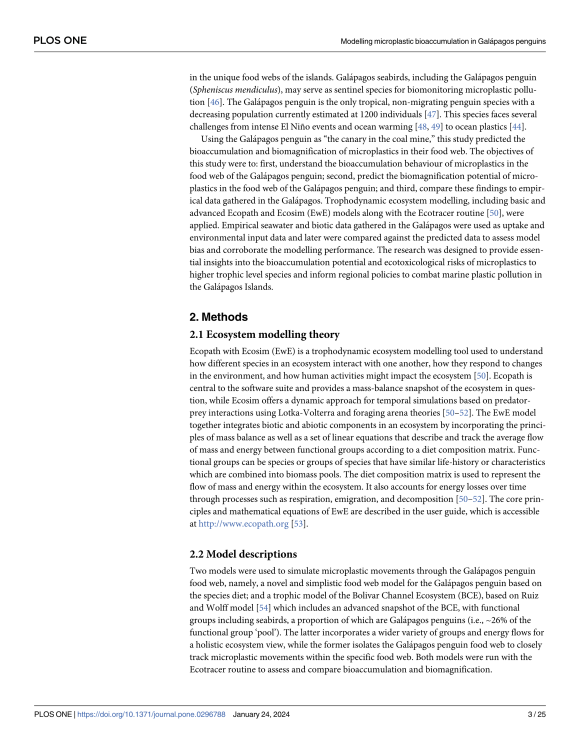






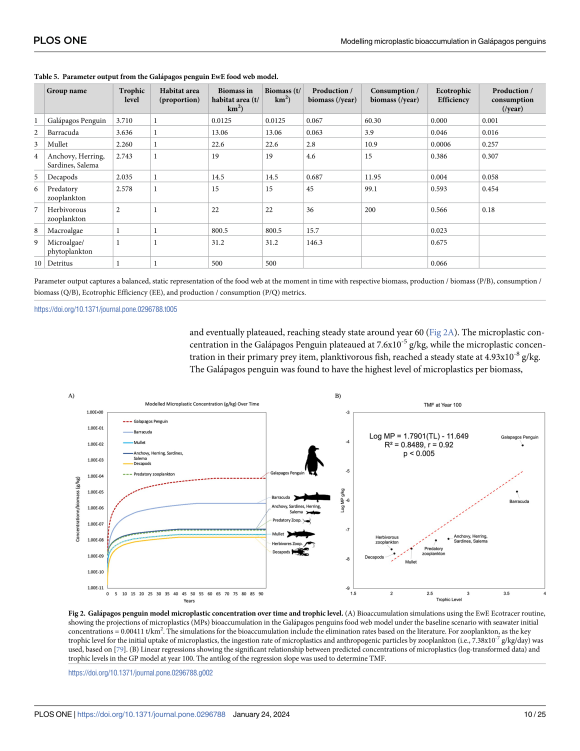


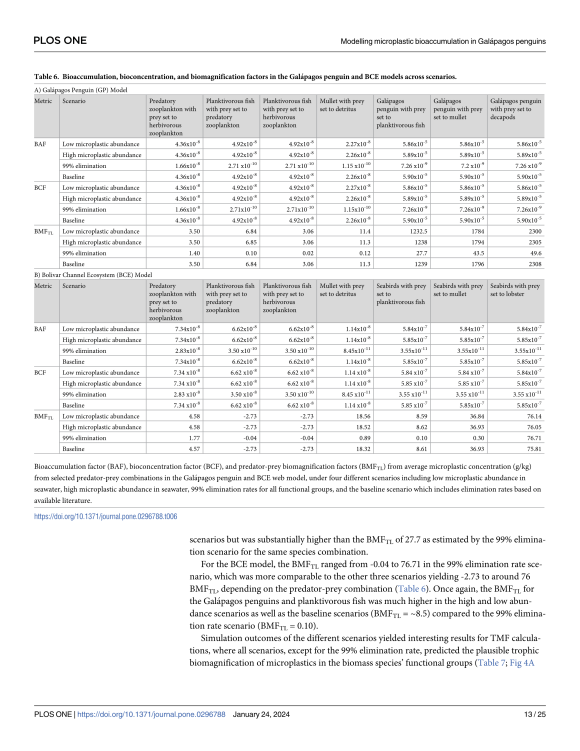
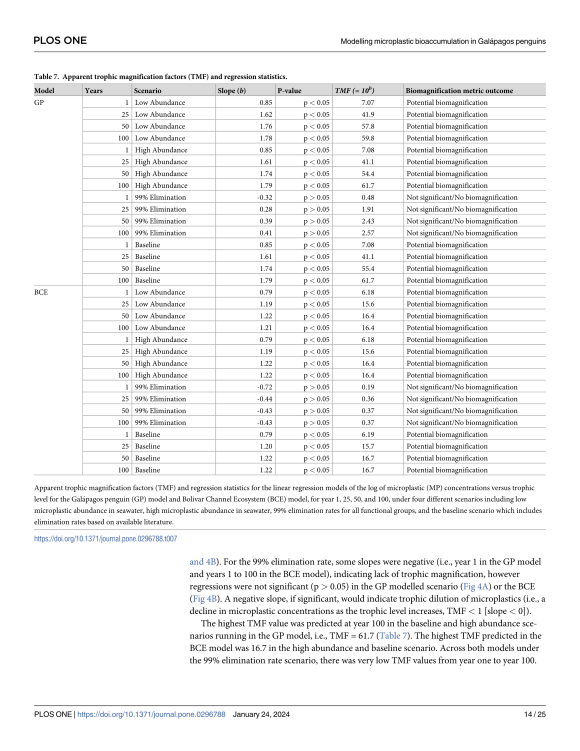


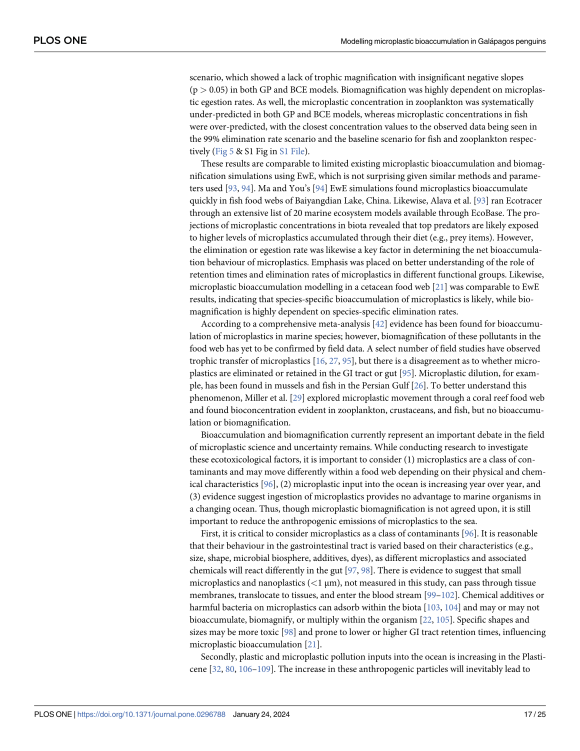





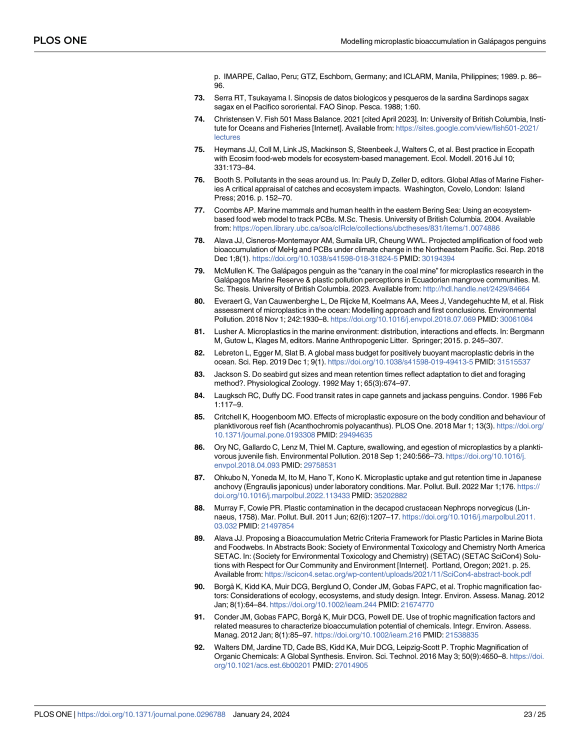


******************************************************************************************************
#미세플라스틱 #시험분석 기술서비스 #시험표준개발 #국제공인시험기관 #KOLAS
#시험/분석 #환경 #수질 #토양 #대기 #폐기물 #타이어 #슬러지
#식품 #음료 #벌꿀 #주류 #소금 #어패류 #해조류 #미세플라스틱분석 #미세플라스틱시험
#세탁폐수 (#미세섬유) #세탁망 #필터 #화장품 #치약 #생활화학제품
#식품용기 #티백 #젖병 #종이컵 #정수기 #젖병소독기
#표준개발 ISO/TC61/SC14, TC38, TC147/SC2&SC6 (Microplastics) Korean Delegate
IEC/TC 111/WG 3 & JWG 14 Co-Convenor
IEC 62321-3-2(#Halogen ),-10 (#PAHs ), -13(#BPA ), -14(#SCCP/MCCP ) Project leader
- 분석장비: #TEDGCMS, #microFT-IR #microRaman, #ICPMS #XRF #Combustion-IC 등
#PAHs분석 #SCCPMCCP분석 #Halogen분석
#ISO/IEC 17025 (국제공인시험기관, KOLAS) 인정 연구소
******************************************************************************************************